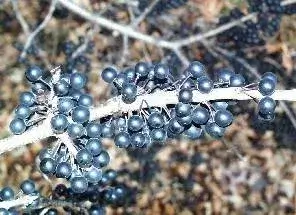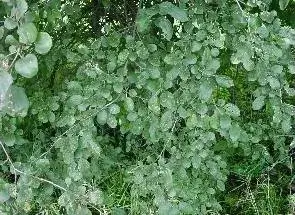
Common buckthorn (Rhamnus cathartica) is a small deciduous tree or large shrub that can grow to six meters in height. It has dull green oval or egg shaped leaves and is easily identified by the small thorns at the tip of its branches. It is also known as European buckthorn, European waythorn, and Hart’s thorn. Common buckthorn is considered an invasive species throughout most of the northeastern and central United States and southeastern Canada because of the dense thickets it forms.
Common buckthorn is native to most of Europe (except Iceland and Turkey) and western Asia. It was brought to North America some time in the 1800s for use as an ornamental shrub and wind break but did not have wide spread distribution until the early 1900s. It is found in hedgerows, along roadsides and on ravine slopes.


Common buckthorn is a perennial shrub or small tree. It is found in lightly shaded areas and is tolerant of many soil types from well-drained sand to clay. Branches are tipped with a short thorn; a thorn may also be found in the fork between two branches. The leaves may be opposite or in an alternating pattern (both may be found on the same branch). The leaves are oval or egg shaped with small, serrated teeth. The leaf may be a dull green or a dark green with a lighter green on the under side. Flowers are small with four sepals (a modified leaf that encloses the petals and other parts of the flower) and four petals and they form small clusters from the axils (the space between a leaf or branch and the stem/stalk of the plant) of leaves or on short twigs along the stem. The flowers are a yellowish to green color. Each flower is unisexual with either four stamens or one pistil with a plant being either male or female (dioecious). The fruit or berries are small (5-6 mm in diameter) and are a dark purplish or black color. Each berry will contain four hard seeds. The common buckthorn flowers during late spring (May-June) while leaves are emerging. The berries ripen during August and September and can be found still attached to the plant throughout the winter.

Buckthorn seeds are easily spread by birds and other wildlife. It is fast growing and will reproduce from seeds or by stump sprouting. The seeds may remain viable in the soil for up to five years.
Common buckthorn can be distinguished from native and other non-native buckthorns by its sharp, thorn-tipped branches and from native Hawthorns (Crataegus spp.) on which the thorns grow from the sides of branches. It also has noticeable forward-curved side veins on its leaves and clusters of purplish-black berries that have 4 hard seeds.

Common buckthorns form thick hedges with long branches that crowd out and shade out native shrub and herbaceous species, preventing regeneration of native plants. In fire prone areas the lack of herbaceous ground cover underneath the buckthorn hedge may prevent fires from spreading.
The common buckthorn is a host for the crown rust fungus (Puccinia coronata), an agricultural pest that inhibits the yield and quality of oats. It may also serve as a overwintering host for the Asian soybean aphid (Aphis glycines Matsumura), a pest known to damage soybeans and can spread a variety of horticultural viruses. Buckthorn leaves have a high concentration of nitrogen and the decomposition of leaf litter changes soil nitrogen content and can increase the pH levels in the soil. These changes create better growth conditions for the common buckthorn perpetuating their persistence.

There are several methods available for control of common buckthorn. These controls include mowing, excavation, cutting and burning. Repeated mowing and cutting has been shown to reduce the vigor of the plants. The plants may be removed by hand or with heavy equipment depending on the size of the shrubs. Care should be taken to not disturb the roots of other plants. The disturbed area, now devoid of the invasive plant, may become the home for new common buckthorn seedlings or other opportunistic invasive plants. As noted earlier, the seeds may persist in the ground for five years resulting in new growth.
Prescribed burns are another way to control buckthorns in fire-adapted ecosystems. Fires will top-kill mature plants; however sprouting can occur from the roots and trunks.
There are also several chemical methods (Table 1) available for controlling common buckthorn. These are generally applied to the stumps after cutting to prevent sprouting. There are no currently known biological controls for common buckthorn. Research into biological controls for common buckthorn is in progress.
| Chemical Name | Use |
| Triclopyr amine | Cut stump |
| Triclopyr ester | Cut stump or basal bark |
| Glyphosate | Cut stump |
(MNDNR 2008)
This map shows confirmed observations (green points) submitted to the NYS Invasive Species Database. Absence of data does not necessarily mean absence of the species at that site, but that it has not been reported there. For more information, please visit iMapInvasives.
